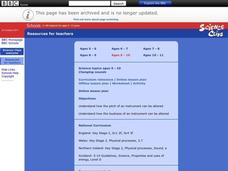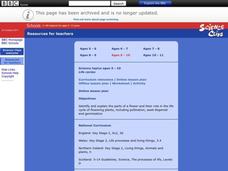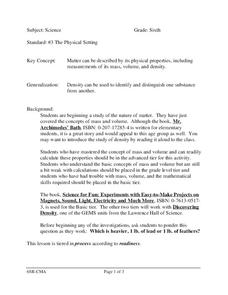Curated OER
Forces in Action
Students investigate different forces and draw arrows to signify specific directions of force. Students are then shown a brick and they are asked to draw a diagram which will include labels for the forces that are acting on the brick....
Curated OER
Forces and Movement
Students investigate the forces of pushing and pulling by participating in a whole group activity involving a toy car. Students then participate in a small group experiment involving a toy car, small weights and various materials....
Curated OER
Life cycles
Students identify and explain the parts of a flower and their role in the life cycle of flowering plants, including pollination, seed dispersal and germination using the Internet. Students will also study and discuss the key points and...
Curated OER
Plants And Animals in the Local Environment
Pupils observe the various living things they can find outside their playground making sure to look both on the ground and in the air. They develop a large poster Venn digram, as a class, of plants and animals that live in the air, on...
Curated OER
Reversible and irreversible changes
Students define the words "reversible" and "irreversible." They complete a worksheet that shows a number of changes. Students must decide which are reversible and which are irreversible.
Curated OER
Pushes and Pulls
Learners discuss and investigate how various vehicles move. In a small groups, students then create a wheeled vehicle and find a way to make it move using various resources provided by the teacher.
Curated OER
The Northern Lights
Sixth graders view photos of Northern Lights and discuss where Northern Lights are usually seen. They examine the colors of light they see and how these colors/lights occur. They use a circular coordinate grid to plot zones of auroral...
Curated OER
Habitats
Learners investigate the habitats of living things and the cycle of the food chain. In this scientific inquiry online instructional activity, students examine the habitats of plants and animals as well as the food chain as they sort...
Curated OER
Solids and Liquids
Learners investigate what happens to solids and liquids when they change from one form to another. In this states of matter activity, students work in groups on a virtual experiment that requires them to collect data regarding the...
Curated OER
Moving and Growing
Young scholars learn to understand the role of both skeletons and exoskeletons. In this lesson on exoskeletons, students locate and label bones on diagram of a human skeleton, and observe and discuss bones of chicken and fish. Young...
Curated OER
Keeping Warm
Learners investigate how different types of objects act as thermal insulators. In this online lesson plan, students hypothesize how particular objects act as insulators and then complete the online activity to determine which materials...
Curated OER
Changing Sounds
Students identify how the pitch and the loudness of an instrument can be altered. In this online science of sound instructional activity, students employ the use of an interactive whiteboard to examine the loudness and pitch of a guitar,...
Curated OER
Changing State
Students investigate the cooling and heating of water. In this online science experiment lesson, students work in groups to make predictions regarding freezing and boiling points and then test those predictions as they complete the...
Curated OER
How We See Things
Students explain that when a beam of light is reflected from its surface, it changes direction. In this virtual science experiment lesson plan, students complete an activity that requires them to investigate how flat mirrors reflect...
Curated OER
Growing Plants
Students explore plants and recognize that they are living things that require light and water to grow. In this online plant biology lesson, students identify, name and match the parts of plants. Extension activities and suggested...
Curated OER
Pushes and Pulls
Students examine different types of movement and causes that may affect those movements. In this online interactive forces and motion lesson plan, students use toy cars to observe push and pull and then make predictions and collect data...
Curated OER
Gases Around Us
Young scholars investigate gases and liquids. In this states of matter online activity, students examine how evaporation plays a part in the transition of liquids into gases as they watch a kettle of water boil and then work in small...
Curated OER
Life Cycles
Students identify and explain the parts of a flower and their role in the life cycle of flowering plants. In this online plant biology lesson, students explore the processes of pollination, seed dispersal, and germination. Extension...
Curated OER
Health and Growth
Students identify healthy foods. In this nutrition lesson, students review the five food groups and categorize healthy and unhealthy foods on a chart. Students develop their own menus.
Curated OER
Characteristics of Materials
Students describe and compare common properties of various classroom materials. In this science/matter lesson, students observe common classroom items and the materials they are made of to complete a list of common properties.
Curated OER
Micro-organisms
Students discuss micro-organisms. In this micro-organisms lesson, students identify which micro-organisms are harmful and which ones are beneficial. Students complete a worksheet which is included in the lesson.
Alabama Learning Exchange
This Is How We Roll!
Students research how roller coasters work. In this physics lesson, learners research the history of roller coasters and the safety factors in the design of a roller coaster on the website www.learner.org/exhibits/parkphysics. They...
Curated OER
Plant Cycles
Young scholars identify plants parts and their functions. In this plant cycle lesson, students examine parts of plants and how the parts help them survive in its environment. Young scholars use graphic organizers, the internet, books...
Curated OER
Physical properties of matter
Sixth graders find the physical properties of matter. In this matter lesson, 6th graders measure mass, volume, and density. Students are broken into 3 tiers with 3 different activities based on their understanding of mass and volume.

























